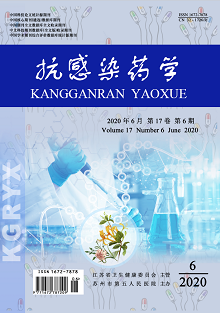DENG Zhi-shi, LEI Jin-hui, LIU Pei-pei, XU Ling
Objective: To analyze the pathogenic bacteria component and drug sensitivity test results of ascites in patients with cirrhosis complicated with spontaneous bacterial peritonitis. Methods: Data of 80 cirrhosis patients complicated with spontaneous bacterial peritonitis admitted from March 2014 to March 2019 were selected to summarize the bacterial culture and drug sensitivity test results of their ascites specimens, and the composition and drug resistance of pathogenic bacteria in their ascites specimens was analyzed. Results: Specimens of 80 cases of liver cirrhosis patients complicated with spontaneous bacterial peritonitis in the ascites in 44 strains detected Gram-negative bacteria (including 21 strains of Escherichia coli, 8 strains of Klebsiella pneumoniae, 4 strains of Acinetobacter baumannii, 4 strains of Pseudomonas aeruginosa, 1 strain of Acinetobacter Lwoffi, 2 strains of Enterobacter cloacae and 4 other strains), in 30 strains of Gram-positive bacteria (including 11 strains of Coagulase-negative Staphylococcus aureus, 6 strains of grass green Streptococcus, 6 strains of Enterococcus, 4 strains of Staphylococcus aureus and 3 other strains) and 6 strains of fungus (including 3 strains of Candida albicans, 2 strains of Subsmooth candida and 1 strain of dark red Candida). Among Gram-negative bacteria, Klebsiella pneumoniae had higher resistance to ampicillin, while the resistance to piperacillin-tazobactam, imipenem and amikacin was the lowest. Escherichia coli had higher resistance to ampicillin and levofloxacin, while the resistance to amikacin was the lowest. Enterococcus in Gram-positive bacteria had the lowest resistance to linezolid, grass green Streptococcus had the lowest resistance to vancomycin, and Staphylococcus had a higher resistance to penicillin G. Conclusion: The pathogenic bacteria in the ascites of patients with cirrhosis complicated with spontaneous bacterial peritonitis were mainly Klebsiella pneumoniae, Escherichia coli, Enterococcus, grass green Streptococcus and Saphylococcus. According to the results of drug sensitivity test, piperacillin-tazobactam, imipenem, amikacin, linezolid, vancomycin and other antibiotics should be selected for clinical treatment.
